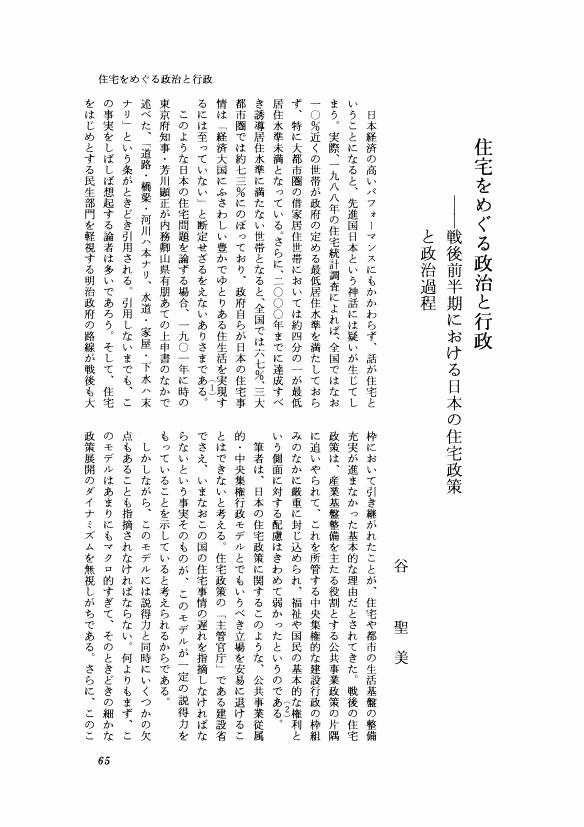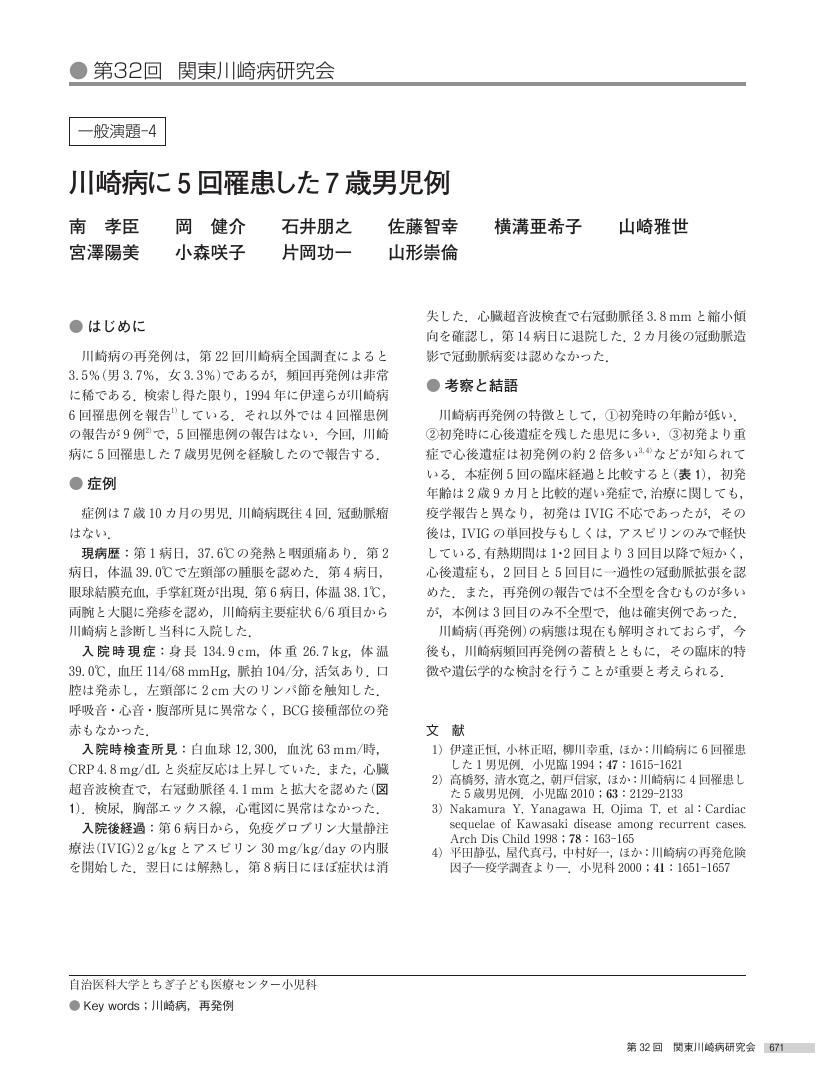7 0 0 0 OA 住宅をめぐる政治と行政 戦後前半期における日本の住宅政策と政治過程
- 著者
- 谷 聖美
- 出版者
- 日本行政学会
- 雑誌
- 年報行政研究 (ISSN:05481570)
- 巻号頁・発行日
- vol.1995, no.30, pp.65-80, 1995-05-20 (Released:2012-09-24)
7 0 0 0 OA 作物統計を用いた作物別・都道府県別の収量変動リスクの定量化
- 著者
- 永井 孝志
- 出版者
- 農業情報学会
- 雑誌
- 農業情報研究 (ISSN:09169482)
- 巻号頁・発行日
- vol.31, no.4, pp.120-130, 2023-01-01 (Released:2023-01-01)
- 参考文献数
- 14
年次的な収量変動に関するリスクマネジメントの手法の一つとして,複数作物の栽培や気候条件の異なる土地での栽培によるリスクの分散がある.しかしながら,作物や地域の網羅的な収量変動リスクの解析事例は報告がない.本研究では,農林水産省による作物統計の長期的な収量データを解析し,47都道府県における160作物の収量変動リスクをそれぞれ定量化した.各年の平年収量と実際の収量の差(平年を100とした場合の作況指数として示す)は,ある確率分布の下でランダムに発生すると仮定し,その分布の平均値と変動の大きさ(標準偏差)をリスク指標とした.また,作況指数の変動パターンとして,気温などの気象要因との関係や,都道府県別の水平分布,水稲の年次変動パターンとの類似性,ハイリスク・ハイリターン度合いなどの観点から整理した.さらに,収量の年次変動パターンに差がある作物や地域を複数組み合わせて栽培することによるリスク分散効果のシミュレーションを行った.その結果,2作物もしくは2地域での作況指数の相関係数が低い場合にリスク分散効果が得られる事例を示すことができた.
7 0 0 0 OA Muse細胞による新規脳梗塞治療法の開発
- 著者
- 新妻 邦泰 冨永 悌二
- 出版者
- 一般社団法人 日本血栓止血学会
- 雑誌
- 日本血栓止血学会誌 (ISSN:09157441)
- 巻号頁・発行日
- vol.32, no.3, pp.296-302, 2021 (Released:2021-06-22)
- 参考文献数
- 34
脳梗塞とは,脳を栄養する血管が閉塞もしくは狭窄することにより,その灌流領域に血流不全が生じ十分な酸素や栄養が供給されなくなり,結果として脳神経細胞が傷害されてしまう疾患である.近年の血栓溶解薬やカテーテル治療の進歩により脳梗塞の転帰は改善してきているものの,未だそれらの再開通療法の適応となる患者は10%未満であり,大半の患者には脳梗塞が完成することになる.脳は脆弱な組織であり,かつ再生能力が限定的であることから,完成した脳梗塞に対する根本的な治療は存在しなかったが,近年では幹細胞治療により脳を再生させられる可能性が見いだされ期待が集まっている.本稿では脳梗塞に対する幹細胞治療の現状を概説後,Muse細胞を用いた新規治療開発につき述べる.
7 0 0 0 OA 学校規模ポジティブ行動支援(SWPBS)を支えるデータシステムとしてのODR
- 著者
- 田中 善大
- 出版者
- 一般社団法人 日本行動分析学会
- 雑誌
- 行動分析学研究 (ISSN:09138013)
- 巻号頁・発行日
- vol.34, no.2, pp.211-228, 2020-03-20 (Released:2021-03-20)
- 参考文献数
- 47
- 被引用文献数
- 7
管理職への規律指導に関する照会(Office Discipline Referral: ODR)は、学校規模ポジティブ行動支援(SWPBS)を支えるデータシステムとして、米国の多くの学校で活用されている。ODRは、問題行動を管理、監督するための方法として、米国の学校で一般的に実施されている手続きであるが、日本ではほとんど馴染みがない。本論文では、SWPBSの実践を支えるデータシステムとしてのODRの特徴とODRのデータを活用したデータに基づく意思決定について解説する。解説に続いて、SWPBSに関連するODRの研究をレビューする。ここでは、ODRデータに基づく意思決定、SWPBSの効果指標としての活用、ODRデータの妥当性及び信頼性に関する研究をレビューする。ODRデータの研究をレビューした後、SWPBSにおけるODRデータの刺激機能について分析する。最後に、日本におけるSWPBSを支えるデータシステムについて考察する。
7 0 0 0 OA 中国地方における火葬時の植込み型心臓デバイスの取り扱いについての調査
- 著者
- 小野広一 山本秀也 木原康樹
- 出版者
- 一般社団法人 日本不整脈心電学会
- 雑誌
- 心電図 (ISSN:02851660)
- 巻号頁・発行日
- vol.39, no.1, pp.33-38, 2019-03-20 (Released:2019-04-10)
- 参考文献数
- 11
【背景】我が国では年間約5万人が新たに植込み型心臓デバイス(CID)植込み治療を受けているが,死後,火葬時の取り扱いについては一定の見解がない.CIDを取り出さずに火葬可能であれば,安心してCID植込み患者を自宅で看取ることができる.【目的および方法】火葬時のCIDの取り扱いについて,中国地方の現状を調べるため,中国地方5県(鳥取・島根・岡山・広島・山口)の162火葬場の管理者(76事業所)に,火葬時の取り扱いについて電子メール・ファックス・電話で調査した.【結果】摘出なしでは火葬不可が8事業所9ヵ所(5.6%),病院で亡くなる場合などでは可能な限り摘出を希望するが,事前の申請があれば摘出なしでも火葬可が42事業所93ヵ所(57.4%),事前の申請があれば摘出なしでも火葬可が27事業所60ヵ所(37.0%)であった.【結論】火葬時の事前申請は必要であるが,中国地方では94.4%の火葬場でCIDを摘出しなくとも火葬が可能であった.(心電図,2019;39:33~38)
7 0 0 0 OA モビリティとモダニティ―近代はいかなる意味で移動的か
- 著者
- 田中 大介
- 出版者
- 日本女子大学
- 雑誌
- 日本女子大学紀要. 人間社会学部 = Faculty of integrated arts and social science (ISSN:09172076)
- 巻号頁・発行日
- vol.24, pp.1-16, 2014-03
7 0 0 0 常刕江戸崎不動院天海ここに顕現す! : 特別展
- 著者
- 稲敷市立歴史民俗資料館編
- 出版者
- 稲敷市立歴史民俗資料館
- 巻号頁・発行日
- 2022
7 0 0 0 OA 明治期以降における外国国名の呼称変遷について
- 著者
- 西脇 保幸
- 出版者
- 日本地理教育学会
- 雑誌
- 新地理 (ISSN:05598362)
- 巻号頁・発行日
- vol.42, no.4, pp.1-12, 1995-03-25 (Released:2010-04-30)
- 参考文献数
- 18
The place-name is essential to geographic studies. We geographic educators, however, are sometimes confused about teaching how foreign place-names should be called and transcribed, because it is not easy to call and transcribe them with a standard. In Japan some authorities tried to solve this problem after a modern school system had been established in the Meiji era. For instance, the Ministry of Education showed the standard of foreign place-names in the official gazette in 1902. After that The Shigaku-kai, NHK (Japan Broadcasting Corporation) and Japan Textbook Research Center showed each guideline for foreign place-names, respectively. Moreover, several geographers and geographic educators contributed several articles of this issue to magazines. In this paper the author examine how the names of foreign countries have been called in 40 Japanese school atlases since the Meiji Era, and investigate the consequence from the viewpoint of international understanding.The author used school atlases for elementary level as to the prewar period, junior high school postwar period, respectively, because they are considered to be important in Japanese national education. After examining the names of foreign countries according to the date, the author could type the consequence of calling and transcribing them as follows.1) countries which have been called and transcribed in a language different from both English and theirs......India, Greece, The Netherlands etc.2) countries which have been called and transcribed in English (excluding English countries)......Argentina, Austria, Egypt, Finland Hungary, Norway, Poland, Sweden etc.3) countries which have been called and transcribed temporarily in their own language, but mainly in English......Spain etc.4) countries which have been called and transcribed at first in English then in their own language......Germany, Italy etc.5) countries which have been called and transcribed in their language......English countries, Portugal, Thailand, countries which got independence after the Second World War etc.Calling and transcribing the names of foreign countries in English was very common in the early Meiji Era because they could get information from English literature. Some coutries began to be called and transcribed in their own language since the mid-Meiji Era, and the guidelines showed such a trend about some countries. However, all guidelines adopted a principle to call former names as far as they were in common use, therefore calling and transcribing in English remains common.It is possible to teach cross-culture by using foreign place-names for international understanding. Particularly the name of a country, which is her symbol and reveals her history and culture, is very significant. Now that Japanese are considered to need more international understanding, the names of foreign countries should be called and transcribed in their own language. The change of calling and transcribing is very difficult though, because of its influence on the social area beyond the school.
7 0 0 0 OA 川崎病に5回罹患した7歳男児例
7 0 0 0 OA 座談会 Gender Equality 2.0 という発想 ─誕生秘話とその後の展開
- 著者
- 鹿野 豊 井野瀬 久美惠 渡辺 美代子
- 出版者
- 公益財団法人 日本学術協力財団
- 雑誌
- 学術の動向 (ISSN:13423363)
- 巻号頁・発行日
- vol.25, no.12, pp.12_97-12_102, 2020-12-01 (Released:2021-05-01)
- 参考文献数
- 4
7 0 0 0 OA 承認の政治と再配分の問題 : ジレンマは存在するか
- 著者
- 辻 康夫
- 出版者
- 北海道大学大学院法学研究科
- 雑誌
- 北大法学論集 (ISSN:03855953)
- 巻号頁・発行日
- vol.67, no.3, pp.348-312, 2016-09-30
7 0 0 0 OA あいりん地区住民の人間関係に関するインタビュー調査
- 著者
- 鍛治 葉子
- 出版者
- 甲子園短期大学
- 雑誌
- 甲子園短期大学紀要 (ISSN:0912506X)
- 巻号頁・発行日
- vol.33, pp.55-60, 2015-03-25
7 0 0 0 OA 熟達化としての叡智 ―叡智知識尺度の開発と適用―
- 著者
- 楠見 孝
- 出版者
- 心理学評論刊行会
- 雑誌
- 心理学評論 (ISSN:03861058)
- 巻号頁・発行日
- vol.61, no.3, pp.251-271, 2018 (Released:2020-01-18)
- 参考文献数
- 44
This study investigated the concept of wisdom as expertise in solving life problems based on an accumulation of life experience. We reviewed and defined the notion of wisdom as practical knowledge and skills, which have developed in the work place. We developed the Wisdom Knowledge Scale (WKS) based on the Berlin Wisdom Paradigm (Baltes & Smith, 2008), and checked the reliability and validity using four measures of wisdom: the Self-Assessed Wisdom Scale (SAWS; Webster, 2007), the Three-Dimensional Wisdom Scale (3D-WS; Ardelt, 2003), the Adult Self-Transcendence Inventory (ASTI; Levenson et al., 2005), and Brief Wisdom Screening Scale (BWSS; Glück, et al., 2013). Based on three survey data (Ns=1074, 997, 1000), participants’ scores on the Wisdom Knowledge Scale increased with age. Structural equation modeling showed that (a) years of education and work experience affected critical thinking attitude and practical knowledge, (b) critical thinking attitude and practical knowledge affected the Wisdom Knowledge score, (c) curiosity and grit affected the Wisdom Knowledge score, and (d) the Wisdom Knowledge score affected happiness. We discuss possibilities for future research on wisdom as expert knowledge using cross cultural, developmental, and interventional approaches.
7 0 0 0 IR 20世紀前半イングランドにおける精神病院と患者 : 規律化から統治性へ
- 著者
- 高林 陽展 タカバヤシ アキノブ Akinobu TAKABAYASHI
- 出版者
- 清泉女子大学人文科学研究所
- 雑誌
- 清泉女子大学人文科学研究所紀要 (ISSN:09109234)
- 巻号頁・発行日
- no.36, pp.182-160, 2015
本稿は、ミシェル・フーコーの規律化と統治性に関する議論を念頭におきつつ、20世紀前半のイングランドにおける精神病院とその患者の問題を検討するものである。フーコーは、18 ~ 19世紀のヨーロッパにおける精神病院の勃興について、非理性の代表格たる狂気を規律化し、理性を持つ者の側に復帰させるための啓蒙主義的試みとして論じた。このフーコーの議論をめぐっては、実証的な歴史学の立場から再検討が加えられ、実際の精神病院の現場では精神病者とその家族の利害が考慮されていたことが明らかとなった。しかし、こうした実証的な研究は、20 世紀の精神病院とその患者たちを視野の外に置いていた。それは、20 世紀の精神病院には19 世紀とは異なる特質が認められるためであった。19 世紀末になって狂気の規律化が失敗に終わりつつあることが徐々に認識されると、精神病院という施設を通じた規律化を高コストなものとして退け、ソーシャル・ワークを中心とした施設外での取り組みが増えていった。このような歴史的展開は、フーコーが「生権力」「統治性」と呼んだ概念の下でより鮮明に理解することができる。フーコーは、近代社会の特徴を、集団レベルでの生命の特性を把握し、その調整を行う権力である生権力、人口集団を政治経済的に統制するための様々な制度や戦術の動員を意味する統治性という二つの概念の下で論じた。つまり、フーコーは、規律化とは異なる管理と統治の技法の存在を示唆している。本稿は、その新たな管理と統治の技法が実際の精神医療の現場においても確認できるものかを問うものである。具体的には、ロンドン近郊に所在したクライバリ精神病院の運営委員会記録を分析し、20世紀前半の精神病者たちは果たして、生権力と統治性という、いわば精神医学の権力に服する存在だったのか。彼ら自身の主体性は認められないのかを検討した。分析の結果、精神病院と精神科医たちは多くの場合、患者とその家族の利害を汲んでいたことが明らかとなった。ただし、フーコーが論じた別の概念、統治手段としての家族、あるいは司牧的権力論を参照すると、患者の主体性を認めることは一概には望ましくないことも確認された。結論としては、20 世紀前半のイングランドにおける精神医療は、ソーシャル・ワークという新たなサービス形態を通じて、患者とその家族の生活へとアプローチし、そのチャンネルを通じた国民生命と健康の管理を目指したことが論じられた。 The aim of this paper is to examine the power relations regarding English mental hospitals in the first half of the twentieth century, paying particular attention to Michel Foucault's conceptions of institutionalization and governmentality. Foucault argued that the enlightenment between eighteenth and nineteenth centuries brought about the sudden rise of mental hospitals in Europe, where insanity, which was regarded as human irrationality, could be cured in the specialized institution, the lunatic asylum, by the exercise of reason. Such an enlightenment approach to lunacy was called "moral treatment". By the late nineteenth century, however, moral treatment had apparently shown its failure, since incurable lunatic patients were accumulated in asylums. Hence, English psychiatrists and welfare administrators thought lunatic asylums represented a high cost approach to the problem of lunacy, and therefore they began employing a new measure for prevention and after care for mental diseases: social work. With such a medico-administrative network for the control of mental diseases, English psychiatr y expanded its reach to the socially problematic families, which presumably corresponded to what Foucault called "governmentality"; a new technology of social control specialized for the social problems in the modern age. It was with this new technology that English psychiatry changed its way of control and mode of power from a vertical one in the institutional settings to a more ubiquitous one throughout the population. What this paper particularly argues for is to examine this historical model based on Foucault in the actual institutionoal and social work settings in the first part of the twentieth century. In doing so, it focuses on the Claybury Mental hospital, located in East London, whose surviving historical documents, particularly the minutes of the management committee, illuminate the practices of the mental hospital and social work. In so doing, it questions whether patients complied with the controlling power of psychiatry, and whether they negotiated with psychiatric authorities any agreements as to the conditions of treatment, social work and other welfare provisions. Furthermore, it also approaches another question; whether we can find any form of subjectivity regarding those who are suffering from mental diseases. To this end, this paper finds that psychiatric authorities, including mental hospitals, psychiatrists and social workers, considered well the interests of the patients and their families in providing services. However, it also argues that English psychiatr y did not acutually concede patients and their families free use of its services, but instead found an instrumental value in administering the problem of mental diseases through the channel of the family. English psychiatry allowed for the subjectivity of patients and their families only when its detective network worked properly and permeated their objects. Any complete deviation from the network was not allowed. In conclusion, therefore, this paper argues that English psychiatry attempted to extend its controlling mechanism, social work, to the depth of the socially problematic population; those who suffered mental diseases.
7 0 0 0 IR 学級内における対抗文化としての 「オタク文化」
- 著者
- 牧野 宏紀
- 出版者
- 奈良大学大学院
- 雑誌
- 奈良大学大学院研究年報 (ISSN:13420453)
- 巻号頁・発行日
- no.23, pp.25-37, 2018-03
" 本研究では学級内の生徒間序列化現象として近年注目される 「スクールカースト」 の議論をサブカルチャー研究に応用し、そこにおいて従来は下位たる存在と見なされてきた 「オタク」 たちの文化が、むしろ 「スクールカースト」 秩序に対する対抗文化として働きうることを示した。ただし 「オタク文化」 は 「スクールカースト」 的秩序と結びついたサブカルチャー・スタイルの序列化に変化を与えることはできても 「オタク」 グループでの同調圧力に対して対抗し得ず、そのため「コミュニケーション能力至上主義」に対する対抗性を持ちえないことも明らかとなった。 なお、本研究は高等学校卒業者を対象として2012年3月から10月にかけて実施した半構造化インタビュー調査の結果に基づいている。"
7 0 0 0 OA 共感性研究の意義と課題
- 著者
- 長谷川 寿一
- 出版者
- 心理学評論刊行会
- 雑誌
- 心理学評論 (ISSN:03861058)
- 巻号頁・発行日
- vol.58, no.3, pp.411-420, 2015 (Released:2018-06-19)
- 著者
- 大戸 夢木 坂上 嶺 日比野 友亮 松重 一輝 内田 和男 望岡 典隆
- 出版者
- 公益社団法人 日本水産学会
- 雑誌
- 日本水産学会誌 (ISSN:00215392)
- 巻号頁・発行日
- vol.88, no.3, pp.152-161, 2022-05-15 (Released:2022-05-21)
- 参考文献数
- 39
- 被引用文献数
- 2
ニホンウナギの成長や降海時の順応の場である汽水域のハビタットの劣化は著しい。本研究では,このハビタットの創出・復元を目標に,本種がどのような浮石間隙構造を好むかを生活史段階ごとに検証した。汽水域において異なるサイズの石(大,長軸30 cm;中,20 cm;小,10 cm)を詰めた石倉カゴ(研究用漁具)の利用状況を比較したところ,未成熟のクロコや黄ウナギは間隙が細かい「小」を好むが,海へ産卵に向かう銀ウナギは「大」,「中」のみで出現した。これは,間隙構造の多様性が河川生活を完結する上で重要であることを示唆している。
- 著者
- 木村 長永 Kimura Choei
- 出版者
- 大阪府立大学大学院人間社会学研究科心理臨床センター
- 雑誌
- 大阪府立大学大学院人間社会システム科学研究科心理臨床センター紀要
- 巻号頁・発行日
- vol.10, pp.47-56, 2017-03-20
- 著者
- Ryoma Kinoshita
- 出版者
- 国立国会図書館
- 雑誌
- National Diet Library newsletter (ISSN:13447238)
- 巻号頁・発行日
- no.213, 2017-08




